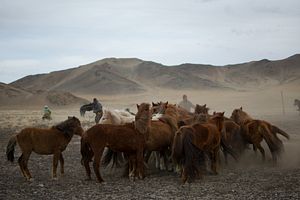“Gadaa aduu dellej baina”—“They’re cutting the horses’ hair outside.”
Filling in the gaps with her hands-turned-scissors mimicry, I was surprised by my own ability to understand the words my host-mother, Enkhchimeg, was saying.
I grabbed my camera and stepped into the furious bluster that characterizes Mongolian spring. Herders and horses kicked dust and dirt, which was caught by the wind and thrown into eyes, ears, and mouths as I photographed the yearly ritual of cutting each horse’s mane.
Mongolian horses have been aptly described to me as “half-wild.” Despite their undersized stature in comparison to their Western counterparts, lifetimes of grazing, running, and playing with the herd have left their spirits uninhibited and whole—gruff and abrasive in both texture and personality. If you held an apple to a Mongolian horse’s face, she would take a momentary pause to gaze at this foreign object and person before putting her head down, returning to graze her familiar pasture.
I entered this whirlwind of hair, teeth, and flying grit with my camera and go-to 50mm lens. I was left in awe as my equipment forced me into close proximity with these half-wild animals and the four men wrangling them.
Dimitri Staszewski is a recording engineer, producer, and an adventurer who enjoys merging his passions for creating multimedia content and exploration. He is currently in Mongolia on a Fulbright-mtvU scholarship. He is adding to his online archive of traditional Mongolian music performed by nomadic herders.










































